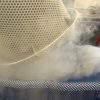Nitrofreeze® Cryogenic Deflashing provides part molders and OEM manufacturers with a fast, consistent, and cost-effective way to remove flash from silicone O-rings. Cryogenic flash removal uses gaseous nitrogen to freeze…
Read More

What Is Residual Mold Flash? Flash is excess plastic or rubber material that forms on the surface of molded parts. Flash, or flashing, affects the part’s surface finish and may…
Read More

Nitrofreeze® Cryogenic Deflashing provides OEM manufacturers, job shops, and molding houses with reliable and efficient way for them to deflash Polyetheretherketone (PEEK) molded parts. Cryogenic deflashing utilizes polycarbonate blast media…
Read More
The Nitrofreeze Deflashing process provides molders and OEM manufacturers with a reliable, efficient method to deflash their molded silicone parts. Cryogenic deflashing utilizes polycarbonate blast media and part tumbling in…
Read More

Nitrofreeze® Deflashing and Deburring process adds value while reducing costs to customers by eliminating the need for hand trimming. Highlighted below is an actual customer part that has successfully undergone the…
Read More
Nitrofreeze® Deflashing and Deburring process adds value while reducing costs to customers by eliminating the need for hand trimming. Highlighted below is an actual customer part that has successfully undergone the…
Read More
Nitrofreeze® Deflashing and Deburring process adds value while reducing costs to customers by eliminating the need for hand trimming. Highlighted below is an actual customer part that has successfully undergone the…
Read More

Nitrofreeze® Deflashing and Deburring process adds value while reducing costs to customers by eliminating the need for hand trimming. Highlighted below is an actual customer part that has successfully undergone the…
Read More
Nitrofreeze® Deflashing and Deburring process adds value while reducing costs to customers by eliminating the need for hand trimming. Highlighted below is an actual customer part that has successfully undergone the…
Read More

Nitrofreeze® Proof of Concept Case Study- Deburring Polysulfone (PSU) Our Cryogenic Deflashing and Deburring process adds value while reducing costs to customers by eliminating the need for hand trimming. Highlighted below is an…
Read More





